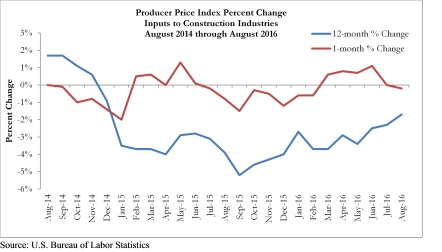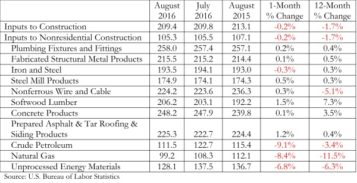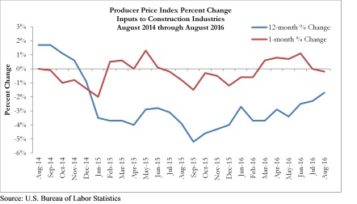
WASHINGTON, D.C. – Both nonresidential construction input prices and overall input prices fell in August as energy prices retrenched, according to a recent analysis of the Bureau of Labor Statistics Producer Price Index released by Associated Builders and Contractors. Nonresidential construction input prices were down 0.2 percent on a month-over-month basis and 1.7 percent on a year-over-year basis.
“The fact that overall construction input prices have remained stable is more important in the current context than it might be normally,” said ABC Chief Economist Anirban Basu. “With industry labor costs now rising aggressively and the subcontracting community generally busy, falling input prices help to moderate growth in total construction costs, allowing more projects to move forward and industry backlog to remain stable.
“There are a number of explanatory factors at work, but weakness in the global economy coupled with a strong U.S. dollar remains at or near the top,” said Basu. “Some construction materials are more globally oriented than others, including crude petroleum, which sustained a 9.1 percent decline in price in August. Materials like concrete, by contrast, are more locally oriented in terms of supply and demand and therefore are less impacted by global economic forces such as disappointing growth in a number of key emerging markets or Brexit. Consequently, while energy prices have trended lower for much of the past two years, concrete prices have been far more stable and are up by nearly 4 percent over the past year.
“With U.S. interest rates likely to rise faster than in many other markets, the U.S. dollar could get even stronger, helping to suppress future materials price increases,” said Basu. This would be particularly true with respect to energy-related inputs. While falling energy prices would negatively impact a number of regional economies across the U.S., the overall impact could be neutral to positive with respect to the durability of the current nonresidential construction cycle.”
Only four of the 11 key nonresidential construction input prices declined in August, however, with this group populated largely by energy-related segments.




 Join our thriving community of 70,000+ superintendents and trade professionals on LinkedIn!
Join our thriving community of 70,000+ superintendents and trade professionals on LinkedIn! Search our job board for your next opportunity, or post an opening within your company.
Search our job board for your next opportunity, or post an opening within your company. Subscribe to our monthly
Construction Superintendent eNewsletter and stay current.
Subscribe to our monthly
Construction Superintendent eNewsletter and stay current.